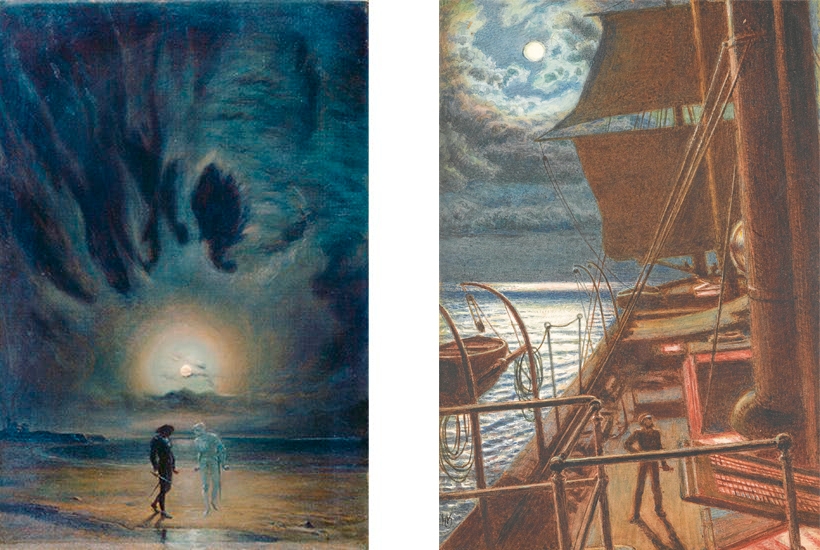In Shakespeare’s A Midsummer Night’s Dream, a group of slightly ramshackle workmen decide to put on a play. The play they choose — The Most Lamentable Comedy and Most Cruel Death of Pyramus and Thisbe — is famously and funnily terrible, as is their handling of it. Its central scene takes place at night, so they decide to dress up one actor with a lantern and a thorn bush: the idea is that light might shine through the thorns and convey the illusion of moonlight. This is an elegant solution, but Peter Quince, who is directing the scene, adds that the actor must explain to the audience that ‘he comes to disfigure, or to present, the person of Moonshine’.
Much of the play’s humour lies in this kind of mangled overexplanation and predictably, when our workmen come to perform their play, the onstage audience laughs. ‘The man in the moon?’ they mock, ‘I am aweary of this moon. Would he would change.’ The joke, of course, is that a single person acting out the moon inevitably misses its essential quality: that it is always changing. When Romeo wishes to swear his love to Juliet, he begins by invoking the moon, but she cuts him off. ‘O, swear not by the moon, the inconstant moon,’ she pleads. ‘That monthly changes in her circled orb,/ Lest that thy love prove likewise variable.’
A new exhibition at the Watts Gallery near Guildford captures this odd slipperiness and variety of the moon. Neatly enough, this year is the 50th anniversary of the first moon landings, and the exhibition — called Moonscapes — both notes the anniversary and returns us to an earlier age. It concentrates upon 19th-century paintings of the moon and its associated mythology, but includes also other moon-related material: a handsome French lunar globe; some more recent prints; a copy of A Midsummer Night’s Dream with splendid illustrations by W. Heath Robinson. This is an assemblage of slightly odd and evocative objects, but they have two things in common. Like Shakespeare’s terrible actors, these painters seem at times a little uncertain of exactly how to represent the moon, and its relation to man. Equally, like Juliet, they are often — and sometimes uncomfortably — conscious of the moon’s reluctance to stay the same.
The moon has always been slippery, even in its earliest myths, which take a recognisably modern form with the figure of Diana, the Roman goddess of the hunt and of the moon. She borrows much of her mythology from the Greek goddess Artemis, but Diana was the focus of renewed and often highly political Roman worship, most famously at a sanctuary near Lake Nemi, south of Rome. Although associated with the crescent moon, her Latin name shares its etymology with the word ‘day’. Cicero explains: ‘Her name Diana derives from the fact that she turns darkness into daylight.’ All of this is deep background, but we see precisely this confusion in many Victorian paintings of the moon: although these scenes are set at night, there is too much light in them, as if moonlight were another, different kind of day. In William Holman Hunt’s ‘Homeward Bound’ (1869), a bright moon lights up a ship, and its dazzling rays reflect upon the sea (see p29).
This sea, or a watery mirror, is often the moon’s counterpart in these paintings. This might be the Thames, or a rainy London street, but the water serves to widen the moonlight until it seems to cover the world. Just as the cult of Diana was bound up with the spread of Rome, here too are the reflections of another empire. The Victorians loved the old cliché that the sun never sets on the British empire, but this is demonstrably untrue, for it implies that the moon never rises; and yet the moon is everywhere here, washing through these paintings and lighting up the world in a way that promises a very imperial idea of progress.
The 19th century was an age of enthusiasm for folklore, science and repression. It was an age that hoped for improvement but was conscious of the dark, and for all these reasons the Victorians were obsessed with the moon. The painting ‘Hamlet and the Ghost’ (1901) by Frederic James Shields shows two figures on a moonlit beach. They are opposites — one light, the other dark; one dead and the other living — but they are also joined, for here are Shakespeare’s Hamlet and his father, and the two men share a name. In the odd bright moonlight, they are also reversed, for the dark figure on the left is living Hamlet while the light one on the right is his dead father Old Hamlet.
Perhaps the subtlest and most fun images in the exhibition are those by the illustrator W. Heath Robinson. He is better known for his cartoons of improbable inventions, but his 1914 illustrations for an edition of Shakespeare’s A Midsummer Night’s Dream are a masterpiece of stylish decadence: all elegant temples and crisp trees in outline. As is fitting for this play, the moon is everywhere, even if it is sometimes hard to tell it from the sun. At the beginning of the volume, on the page of dramatis personae, a sphere drawn in a single thin line might be the sun or the full moon. On the closing page, a perfect new moon floats above the words ‘THE END’ as fairies tumble down to earth. This end is another beginning.
Where the sun keeps the time, the wavering, unreliable moon confuses it. ‘This lunar beauty/ Has no history’ wrote W.H. Auden in his poem ‘This Lunar Beauty’, and unpacks the kind of backwards thinking that always seems to accompany the moon:
This like a dream
Keeps other time
And daytime is
The loss of this;
Now that man has walked upon the moon, we might assume that it has been tamed, and perhaps we have lost some of its strange magic. It is an obvious point, but the bright moonlight of these Victorian paintings has been dimmed in modern cities filled with streetlights. Shakespeare, Heath Robinson and the Victorian painters are all, as in the player’s malapropism, disfiguring the moonshine, or at least engaging in a little moonshine thinking. The pun is irresistible, for moonshine also means illegally distilled liquor, and tipsiness is a characteristic of these older ways of thinking about and looking at the moon: a little blurred, or unsteady, and slippery with the time.






Comments